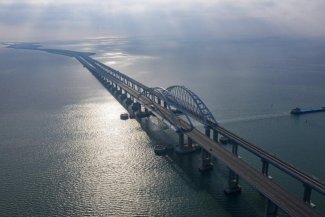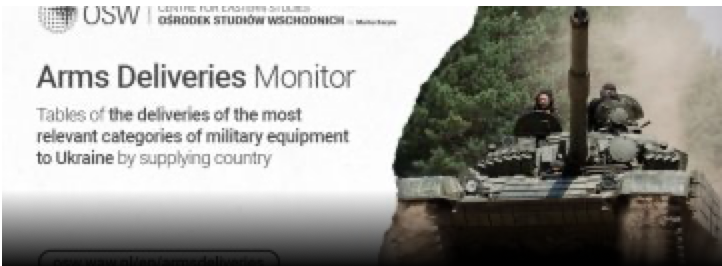Second successful attack on the Crimean Bridge. Day 509 of the war

At dawn on 17 July, the Crimean Bridge was attacked, resulting in damage to pillars of the bridge and the span adjacent to them, which slid into the water. Only one of the two carriageways of the bridge’s road section was damaged, while the railway line running in parallel to them was untouched. Within a day of the strike, civilian vehicle traffic on the bridge resumed on a shuttle basis. Kyiv has not officially claimed responsibility for the attack, although according to unofficial reports it was planned and executed by the Ukrainian Security Service and the Ukrainian Navy with the use of naval drones. The Ukrainians also attacked targets located in the Russian rear (Luhansk, Berdyansk and Mariupol) with long-range missiles in recent days, although the effects of these strikes are still unknown. According to the Russians, there were also two massed Ukrainian drone attacks on Crimea. On the night of 15–16 July, there was a synchronised sea and air drone strike on Sevastopol, and on the night of 17–18 July, the Ukrainians used 32 aerial drones. Russian sources claim that both attacks on Crimea were repulsed without losses.
The situation on the front has not fundamentally changed since 14–18 July. Heavy fighting is ongoing in several areas, with no significant impact on either side’s position. In the south, the Ukrainian army is breaking through the Russian minefields near the village of Robotyne, and has reached the first line of the enemy’s defence. The Ukrainians are also attacking in the Velyka Novosilka area, where the heaviest battles are being fought over Pryyutne and Staromayorske. There are also reports of pinpoint offensive actions being launched on a section of the front manned by the Russian 35th Army, which is defending the exit from Huliaipole to Polohy in a strip running from the T0803 road near Novopokrovka to the vicinity of Novozlatopil. Heavy fighting is also continuing near Bakhmut, with the Russians having committed their reserves (primarily from the airborne troops) to the key directions (the area around the village of Berchivka, as well as Kurdiumivka, Andriivka and Klishchiivka, which are north and south of the town). Their counterattacks have so far been successful in holding back the Ukrainian advance.
The Russians are maintaining the initiative in the area bordering Kharkiv, Luhansk and Donetsk oblasts. According to the spokesman for the eastern grouping of the Ukrainian army, Colonel Serhiy Cherevaty, the Russian grouping operating in the Kupiansk and Lyman directions numbers at least 100,000 troops, with more than 900 tanks, 555 guns of various calibres and 370 multi-propelled rocket systems. In recent days, the Russians have been attacking the vicinity of the villages of Masiutivka and Lyman Pershy (north-east of Kupiansk), Novoselivske (north-west of Svatove), Karmazynivka, Novovodyane, Ploshchanka and Torske (along the line of the Zherebets river) as well as in the forest massif above the Donets. In several sections, Russian troops from the 6th Army, the 1st Tank Army, the 11th Army Corps, the 2nd and 41st Armies and the airborne troops assigned to them have enjoyed minor successes, pushing the defenders westwards. Of note was the Russian capture of a small bridgehead on the west bank of the Zherebets river near Karmazynivka. The fighting on the front from Kupiansk to the Donets is heavy, and the Ukrainians have probably been forced to divert reserves there.
On the night of 14–15 July, the Russians attacked Ukrainian territory with six Shahed-136/131 drones, four of which were shot down by Ukrainian air defences. A massive strike of drones and cruise missiles occurred on the night of 17–18 July, presumably as a Russian response to the attack on the Crimean bridge. The aggressor used six Kalibr missiles to strike Odesa, and sent 36 drones mostly towards Odesa and Mykolaiv. The Ukrainian Air Force Command announced that they had shot down all the missiles and 31 of the drones. Some of the drones hit Mykolaiv, causing a fire at an industrial facility. The Russians also used S-300 missiles to attack Kharkiv.
According to information gathered by the Ukrainian military intelligence service (HUR), 500–700 Wagner Group troops arrived in Belarus between 11 and 17 July (to the Asipovichy area of Mahiliou oblast). HUR spokesman Andriy Yusov said that some of the mercenaries would be engaged in training soldiers of the Belarusian and Russian armies, while the rest would carry out tasks related to “irritating” Poland and other EU and NATO member states. He stressed that the presence of the Wagner forces in Belarus does not pose a direct threat to Ukraine – if only because they are entering unarmed. Earlier, Ukrainian border service spokesman Andriy Demchenko did not rule out the possibility that the mercenaries could be used to destabilise the situation in areas near the border with Ukraine “or other countries” neighbouring Belarus. On 14 July, the Belarusian defence ministry reported that a ‘roadmap’ for involving the Wagner troops in training Belarusian soldiers had been drawn up. On 18 July, independent Belarusian media reported that a fifth column made up of more than 30 of the mercenaries’ vehicles was approaching the country’s borders.
According to the Washington Post of 15 July, the most significant obstacle to the progress of the Ukrainian forces’ counter-offensive are the minefields and engineering barrages covering the main lines of Russian defence at a depth of 5 to 16 km. The highest density of minefields is found along the southern front line in the Zaporizhzhia region. According to the Supreme Commander of the Ukrainian Armed Forces, Valerii Zaluzhnyi, Ukrainian forces are suffering from a shortage of special equipment for remote demining.
On 18 July, the Minister of Defence of the Republic of China (Taiwan) dismissed earlier reports in the Taiwanese China Times that the Republic of China (Taiwan) Armed Forces would sell the United States its recently decommissioned MIM-23 HAWK short-range air defence sets, which would then be transferred to Ukraine.
Commentary
- Ukraine’s successful attack on the Crimean bridge was the second, after the strike last October. The bridge is a symbol of the Russian occupation of the peninsula, and the Ukrainian attack can thus be said to primarily have a propaganda dimension. It shows Ukrainians the prowess of their armed forces and special services, and is intended to heighten the chaos and sense of humiliation among both Russia’s public and its ruling elite. It should be noted that the attack occurred during the holiday season, when thousands of tourists pass over the bridge each day. The bridge is also the main supply route to Crimea. However, the damage to the facility does not appear to have directly disrupted the logistics of the Russian grouping fighting in southern Ukraine, which mainly relies on road and rail transport coming out of the Donbas; this is duplicated by the railway line which runs across the Crimean bridge, and that was not damaged.
- Of note is the intensification of Russian offensive operations in the area stretching from the state border to the River Dnieper at the junction of Kharkiv, Luhansk and Donetsk oblasts. Back in the winter, the invaders had concentrated their forces along a section of the front about 100 km in length. This agglomeration consisted of troops from the Western and Central Military Districts, and was comparable in the number of committed brigades and mechanised, armoured and landing-strength divisions to the Russian grouping fighting in southern Ukraine (along the lower Dnieper and along the Zaporizhzhia front). They had been attempting for some months to push the Ukrainians westwards towards the Zherebets river, but had not been successful. It is possible that over the coming weeks the Russians will try to launch a coordinated attack along a broad front towards Kupiansk and Lyman. Its main objective will be to push Ukrainian reinforcements back so that they cannot be used in other areas where the situation is developing in a manner unfavourable to the invaders. At the same time, it should be stressed that the advance of the mechanised forces in this area is being hampered by the terrain, which mainly consists of several rivers with swampy valleys running in parallel to the front line.





